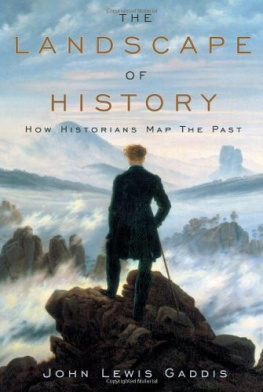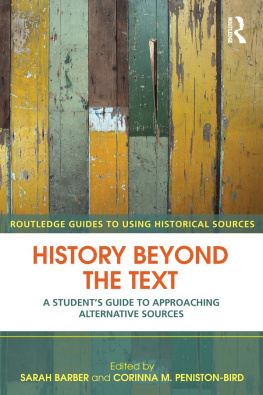THE LANDSCAPE OF HISTORY
ALSO BY JOHN LEWIS GADDIS
The United States and the Origins of the Cold War, 19411947
Russia, the Soviet Union, and the United States: An Interpretive History
Strategies of Containment: A Critical Appraisal of Postwar American
National Security Policy
The Long Peace: Inquiries into the History of the Cold War
The United States and the End of the Cold War: Implications,
Reconsiderations, Provocations
We Now Know: Rethinking Cold War History
THE LANDSCAPE OF HISTORY
How Historians Map the Past
JOHN LEWIS GADDIS


Oxford New York
Auckland Bangkok Buenos Aires Cape Town Chennai
Dar es Salaam Delhi Hong Kong Istanbul Karachi Kolkata
Kuala Lumpur Madrid Melbourne Mexico City Mumbai Nairobi
So Paulo Shanghai Singapore Taipei Tokyo Toronto
Copyright 2002 by John Lewis Gaddis
Published by Oxford University Press, Inc.
198 Madison Avenue, New York, New York 10016
www.oup.com
Oxford is a registered trademark of Oxford University Press
All rights reserved. No part of this publication may be reproduced, stored in a retrieval system, or transmitted, in any form or by any means, electronic, mechanical, photocopying, recording, or otherwise, without the prior permission of Oxford University Press.
Library of Congress Cataloging-in-Publication Data
Gaddis, John Lewis.
The landscape of history : how historians map the past / John Lewis Gaddis.
p. cm. Includes index.
ISBN 0-19-506652-9
1. HistoryPhilosophy. 2. HistoryMethodology.
3. AestheticsHistory. I. Title.
D16. 8.G23 2002 901dc21 2002010392
Book design and composition by Mark McGarry, Texas Type & Book Works. Set in Linotype Fairfield .
9 8 7 6 5 4 3 2 1
Printed in the United States of America
on acid-free paper
For Toni
The Love of Life and a Life of Love
CONTENTS
PREFACE
T HE U NIVERSITY OF O XFORD has again provided a hospitable setting in which to write a book. The occasion this time was the 2000/1 George Eastman Visiting Professorship in Balliol College, a chair dating back to 1929 whose occupants have included Felix Frankfurter, Linus Pauling, Willard Quine, George F. Kennan, Lionel Trilling, Clifford Geertz, William H. McNeill, Natalie Zemon Davis, and Robin Winks. As befits a position with such diverse and distinguished predecessors, the Eastman electors do not find it necessary to provide current chairholders with detailed instructions as to what they are expected to do. My own letter of appointment specified only participation in twenty-four academic functions during the three terms of the academic year. It then added, accurately enough as I discovered, that the Eastman Professor enjoys considerable scope for flexibility in adjusting the pedagogical activities in combination with scholarly projects which the holder may wish to pursue.
Confronted with so much latitude in so congenial a setting, I was at first at a loss to know how to use my time. One possibility, I suppose, would have been simply to dine: high table at Oxford is definitely an academic function. Another would have been to spend the year doing research, but this would have disappointed my hosts, who clearly expected some sort of visibility. A third would have been to lecture on Cold War history; but Id done that as Harmsworth Professor eight years earlier and had since published the lectures. Even in a rapidly changing field like this one, would there be that much new to say? I rather doubted it.
So in the end, I settled on something completely different: a set of lectures, delivered as before in the Examination Schools building on High Street, on the admittedly ambitious subject of how historians think. I had several purposes in mind in undertaking this project, the first of which was to pay homage to scholars now dead and to students very much alive, both of whom had taught me. The scholars, in particular, were Marc Bloch and E. H. Carr, whose respective introductions to the historical method, The Historians Craft and What Is History? , first forced me to think about what historians do. The students were my own, undergraduates and graduates at Ohio, Yale, and Oxford universities, with whom Id spent a good deal of time discussing these and other less familiar works on historical methodology.
A second purpose derived from the first. Id begun to worry that all this reading and talking might soon begin to produce, in my own mind, something like the effect Cervantes describes when a certain man of La Mancha read too many books on knight-errantry: he so bewildered himself in this kind of study that... his brain... dried up, [and] he came at last to lose his wits. I felt the need, at this stage in life, to begin to sort things out, lest I start attacking windmills. Its possible, of course, that Ive already arrived at that stage, and that these lectures were the first offensivebut Ill leave that for my readers to judge.
My third purposewhether or not Id dodged the dangers implied in the secondwas to do some updating. A lot has happened since the Nazis executed Bloch in 1944, leaving us with a classic that breaks off, like Thucydides, in mid-sentence; and since the more fortunate Carr completed his George Macaulay Trevelyan lectures, which became his classic, at Cambridge in 1961. Its my impression, though, that its not so much they as we who need the updating. For Bloch and Carr anticipated certain developments in the physical and biological sciences that have brought those disciplines closer than they once were to what historians had been doing all along. Most social scientists have hardly noticed these trends, and most historians, even as they read and teach Bloch and Carr, neglect what these authors were suggesting about a convergence of the historical method with those of the so-called hard sciences.
That suggests my fourth purpose, which was to encourage my fellow historians to make their methods more explicit. We normally resist doing this. We work within a wide variety of styles, but we prefer in all of them that form conceal function. We recoil from the notion that our writing should replicate, say, the design of the Pompidou Center in Paris, which proudly places its escalators, plumbing, wiring, and ductwork on the outside of the building, so that theyre there for all to see. We dont question the need for such structures, only the impulse to exhibit them. Our reluctance to reveal our own, however, too often confuses our studentseven, at times, ourselvesas to just what it is we do.
Bloch and Carr had little patience with such methodological modesty, The reason is not just that Bloch and Carr were accomplished methodologists: weve had many since and some more skilled. What distinguished them was the clarity, brevity, and witin a word, the elegancewith which they expressed themselves. They showed that you can discuss ductwork gracefully. Few methodologists attempt this today, which is why they speak mostly to themselves and not to the rest of us. Im sure its quixotic, on my part, even to aspire to the example of these two great predecessors. But I should like at least to try.
It remains only to thank the people who made this project possible: Adam Roberts, who kindly suggested a return visit to Oxford eight years ago as I was completing my first; the Association of American Rhodes Scholars, for supporting the Eastman Professorship and for providing such comfortable lodgings in Eastman House; the master and fellows of Balliol College, who in so many ways made my wife Toni and me feel welcome there; the students, faculty, and friends who attended my lectures, and who provided so many insightful comments on them in the question period afterwards; my indefatigable Yale research assistant Ryan Floyd; and, finally, several careful and critical readers of these chapters in draft form, especially India Cooper, Toni Dorfman, Michael Frame, Michael Gaddis, Alexander George, Peter Ginna, Lorenz Lthi, William H. McNeill, Ian Shapiro, and Jeremi Suri. I should also like to thank the Oxford microbes, which were much more manageable than they had been eight years earlier.
Next page













